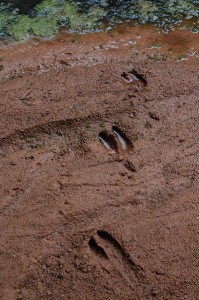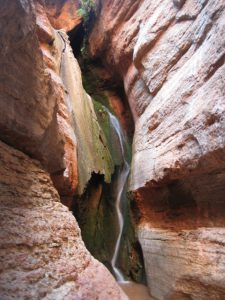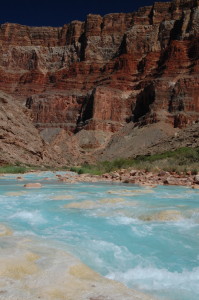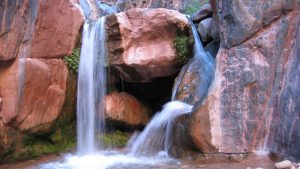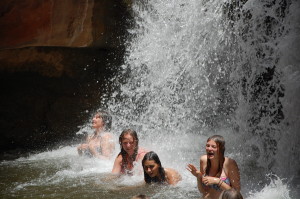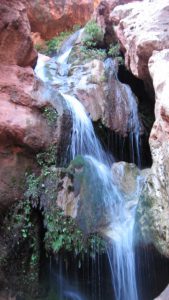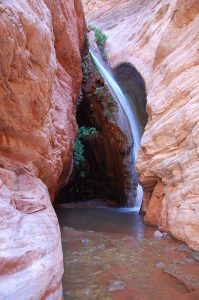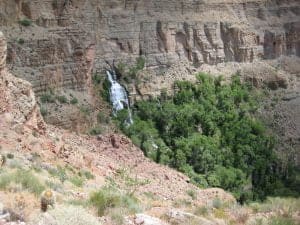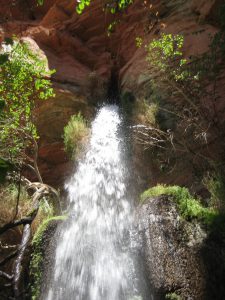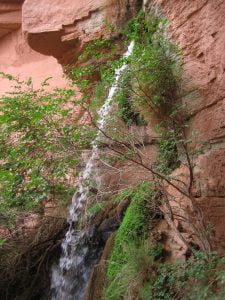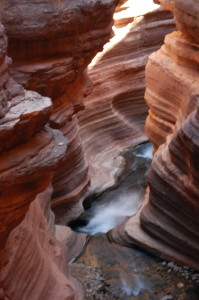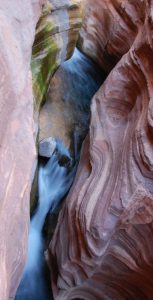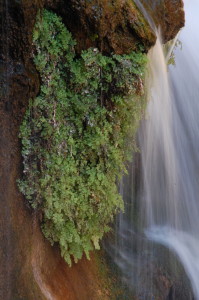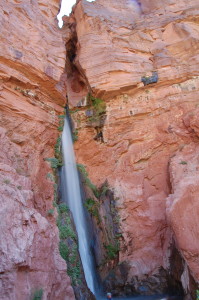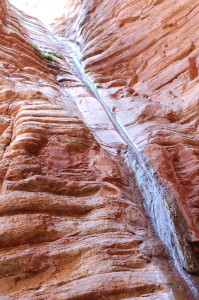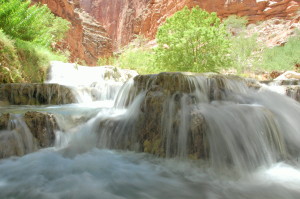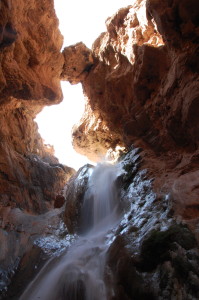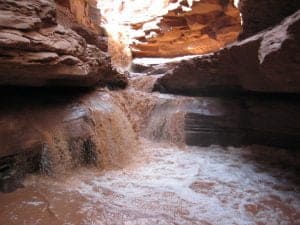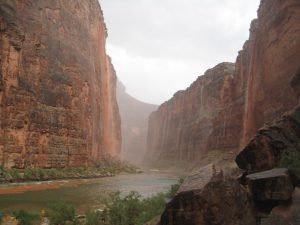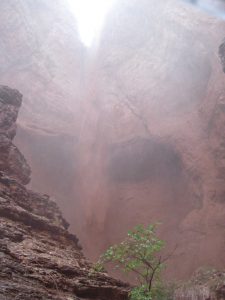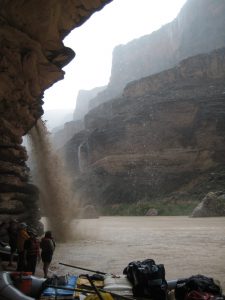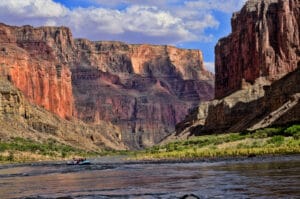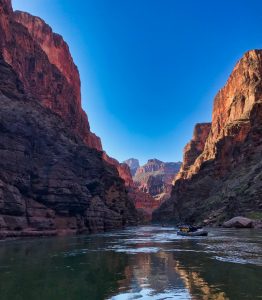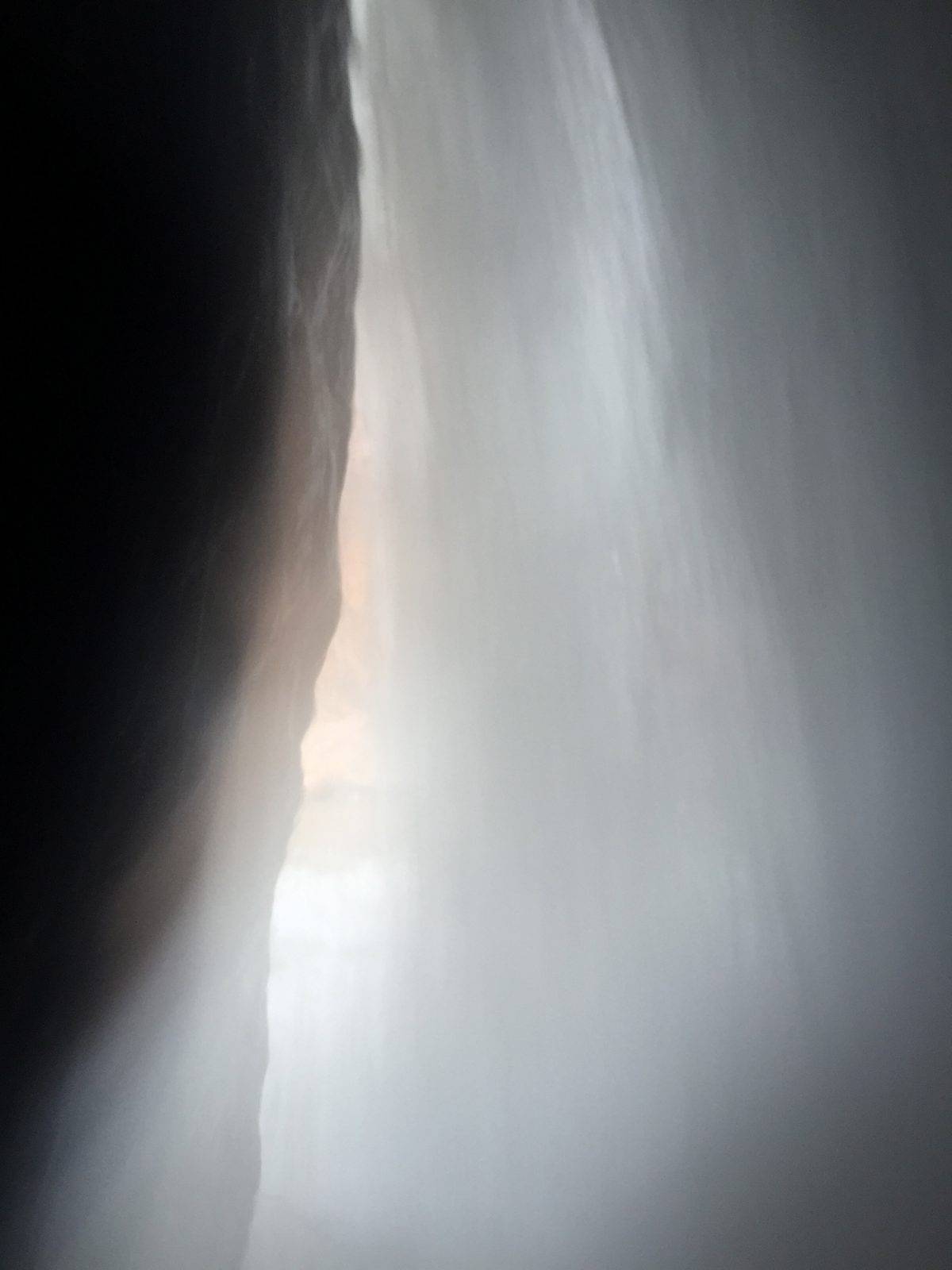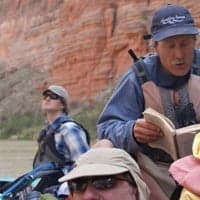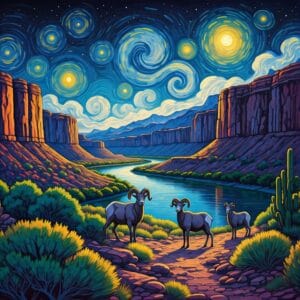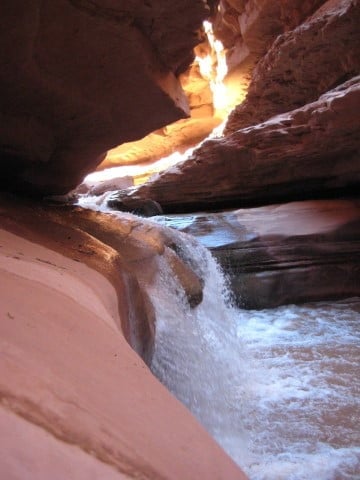
What is it that draws us to falling water? Is it the height of the cliff wall from which the water spills? The volume of water cascading down the rock? Or is it the way that we feel when standing at the bottom of a waterfall? Along the side canyons of Colorado River and throughout the desert landscape of the arid Colorado Plateau- seeps, springs and waterfalls seem like an anomaly. Where red rock radiates like a solar oven in the sun, the verdant micro-climate associated with waterfalls creates a welcoming contrast. Maidenhair fern, crimson monkeyflower and columbines abound. Frogs croak, birds chirp and the footprints of desert big horn sheep are found at favorite watering holes.
It is no surprise then, that the ancient civilizations that made these canyons home revere these places with reverence. These places are not just a pristine water source in the desert. Many tribes that call Grand Canyon home understand that their ancestors emerged from the previous world to this one from where the water surfaces. Ribbon Falls is very sacred to the Zuni, the Little Colorado River to the Hopi, Deer Creek Falls and Narrows to the Piute, and Havasu Creek to the Havasupai. While visiting these places the feeling that you are somewhere special is evident. Here are a few that we stop at along the river;
The falls at the end of Saddle Canyon.
Calcium carbonate-rich waters of the Little Colorado River where we swim.
Above Phantom Ranch and in the Inner Gorge is a short walk up Clear Creek Canyon to this unique waterfall.
Playing in Shinamu Falls.
The magic of Elves Chasm. Here the water spills through Travertine Limestone where maiden hair ferns find refuge in nooks and crannies.
Upper Stone Creek Falls is found in the end of a box canyon, 3.5 miles from the river, and past a series of waterfalls along the way.
Thunder River comes shooting out of the Muav Limestone and is seen while hiking the “Death March”, an 11 mile loop from Tapeats Creek and ending at Deer Creek.
Dutton Springs is one of the sources of Deer Creek, best seen from the “Throne Room” on the up and over hike.
Deer Creek Narrows and Falls is sacred to Piute Indians and river runners.
Whispering Springs trickles down to a pool 3.5 miles up Kanab Creek.
Matkatamiba Canyon, with a thin sluice of water carving through the Muav Limestone.
Havasu Creek and it’s blue water- rich with calcium carbonate like the Little Colorado- forms pools and falls through towering canyon walls.
At the lower end of Grand Canyon is where a short hike leads to Travertine Grotto.
In Cataract Canyon, within Canyonlands National Park is where Indian Creek Falls is found- when the snow melts from the Abajo Mountains- and after big rain storms.
The reward for surviving heavy monsoon storms in July and August. To see rim falls like these are a rare and unique experience!
The awe one feels when witnessing a waterfall must be a universal feeling. People all over the world, from all generations go to these places for the experience. Beyond the beauty and the cooling mist that makes the hot summer months feel cool, it is the way that we feel in the presence of falls. Lately I have been trying to tap into what it is I feel while up close to falling water. In certain places and when I am alone I feel and hear a vibration that is unmistakable. I don’t know how to explain it, but feel like I am experiencing one of earth’s deep coursing rhythms that is unique but connected to the fundamental need for water, for survival.
When we take people to these places, even the most serious adults become children. We splash and play while societal concerns on how we must act as grown-ups is abandoned. In the Little Colorado River we swim through the riffles of a small rapid. I see trip after trip- the most conservative people- drop down their preconceptions of how they ought to act and tap into something they lost after childhood. These are life-changing events, and always a highlight of our river trips.
There are threats to this experience. The Tusayan development proposed by Italian developers on the South Rim of the Grand Canyon plans to build 2,100 housing units and develop 3 million square feet of commercial real estate. With no obvious water source, the plan would most likely draw from the underlying Redwall-Muav aquifer that is the source of water for many of the springs and waterfalls emerging from the South Rim. The development could affect the waters of the Little Colorado River, Elves Chasm, Matkatamiba Canyon and Havasu Creek. Click on the link above to learn about how you can get involved. Alicyn Gitlin from the Sierra Club goes on to say this about the threat to water in Grand Canyon;
“The National Park Service considers the mega-development a significant threat to Grand Canyon because it will require vast quantities of water and could lower the aquifer that feeds seeps, springs, and streams that support wildlife and recreation on the park’s South Rim. Groundwater pumping accompanying the development could also lower the aquifer that is the exclusive source of all water for Havasu Falls, the cultural foundation of the Havasupai tribe.
Models predict that pumping from the Redwall-Muav aquifer, which lies below Tusayan, will reduce the yield of, or dry up, South Rim seeps and springs. After wells were drilled in Tusayan and Valle in 1994, Cottonwood Creek turned from perennial to intermittent and Pumphouse Spring’s flow began declining. Base flow at Cottonwood Creek decreased 19% between 1995 and 2001; base flow at Indian Gardens decreased 25% between 1994 and 2001. These decreases began before the current drought cycle began but after wells were drilled. There has been “a declining trend in annual winter base flow since the late 1990s” for Havasu Creek below Havasu Spring.
The National Park Service estimates that water use in Tusayan could quadruple if the development is fully built out.
Northern Arizona is likely to reach an unsustainable demand for water before 2050.”
-Alicyn Gitlin, Sierra Club
This is a critical time to take part in the protection of Grand Canyon. For the experience of visitors, and for the possibility of this experience for those that will come next. For the fragile ecosystem of the Grand Canyon, and all the species of plants, animals and insects that depend on the water flowing. And for the Native American tribes- past, present and future- that consider this water sacred.
Recently, certain tribal members have explained to us details about their relationship with the canyon and the water that runs through it. They tell us that the veil between the past, present and future is very thin- and that the spirit of their ancestors is very much present today. So disturbances today affect the people of the past, the people here now and those that will come next. They ask us to visit these special places with reverence and respect. By doing this we are free to share our own experience with each other without disturbing the spirit of the Canyon.
Laughing, splashing, playing. Becoming a child, taking pictures or just cooling off from the harsh desert sun. We all seek the beauty of waterfalls for different reasons. It is time now to protect the experience by writing letters to the congressmen in Arizona, and by making comments when the public comment period opens up. These places are worth fighting for!
-Ben Reeder

